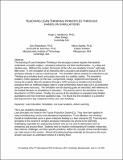Teaching Lean Thinking Principles Through Hands-on Simulations
Author(s)
McManus, Hugh L.; Rebentisch, Eric; Muman, Earll M.; Stanke, Alexis
DownloadCP_070611_McManus-Murman-Rebentisch-Stanke_CDIO.pdf (423.2Kb)
Terms of use
Metadata
Show full item recordAbstract
The teaching of Lean Enterprise Thinking in the aerospace context requires that students understand a complex subject—aerospace enterprises and their transformation—in a deep and intuitive way. Without this context, the lessons of the LAI Lean Academy Course® will make little sense. A rich simulation of an enterprise with a structure and problems typical of the US aerospace industry is used as a teaching tool. The simulation allows students to understand Lean Thinking at an intuitive level, and practice lean tools in a realistic setting. The simulation enables a CDIO approach (in this case, Comprehend, Design, Implement and Operate), by having the students take two iterations through a CDIO process to transform the simulated enterprise from an inefficient legacy state to a high performance future state (x3 to x6 production using the same resources). The simulation and its teaching goals are described, with reference to the limited literature on simulations in education. The process used in the simulation is then described in a CDIO context. Finally, the success of the simulation is evaluated using limited quantitative and more extensive qualitative data. It is found that the simulation is a powerful learning tool and a key component of the LAI Lean Academy.
Date issued
2007-06-11Keywords
lean education, simulation, LAI Lean Academy, active learning
Collections
The following license files are associated with this item: